eclipse操作说明书
Eclipse IDE开发环境使用教程说明书
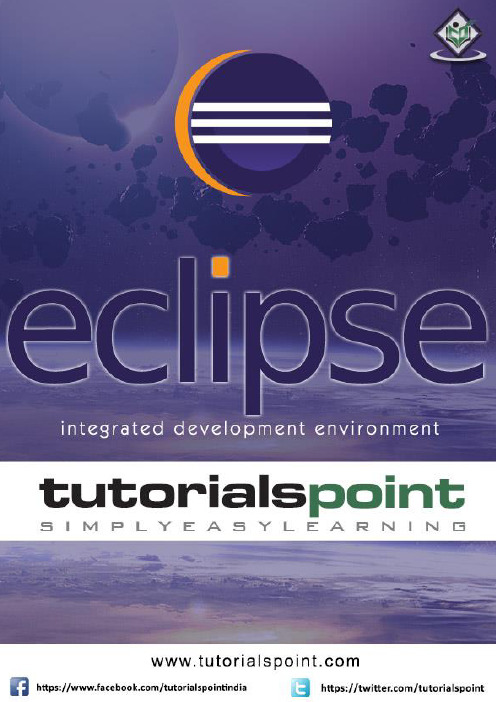
iAbout the T utorialEclipse is an integrated development environment (IDE) for Java and other programming languages like C, C++, PHP, and Ruby etc. Development environment provided by Eclipse includes the Eclipse Java development tools (JDT) for Java, Eclipse CDT for C/C++, and Eclipse PDT for PHP, among others.This tutorial will teach you how to use Eclipse in your day-2-day life while developing any software project using Eclipse IDE. We will give special emphasis on Java project. AudienceThis tutorial has been prepared for beginners to help them understand basic functionality of Eclipse tool. After completing this tutorial, you will find yourself at a moderate level of expertise in using Eclipse IDE from where you can take yourself to next levels. PrerequisitesWe assume you are going to use Eclipse IDE to handle all levels of Java projects development. So it will be good if you have knowledge of software development using any programming language specially Java programming.Copyright & Disclaimer© Copyright 2015 by Tutorials Point (I) Pvt. Ltd.All the content and graphics published in this e-book are the property of Tutorials Point (I) Pvt. Ltd. The user of this e-book can retain a copy for future reference but commercial use of this data is not allowed. Distribution or republishing any content or a part of the content of this e-book in any manner is also not allowed without written consent of the publisher. We strive to update the contents of our website and tutorials as timely and as precisely as possible, however, the contents may contain inaccuracies or errors. Tutorials Point (I) Pvt. Ltd. provides no guarantee regarding the accuracy, timeliness or completeness of our website or its contents including this tutorial. If you discover any errors on our website or inthistutorial,******************************************iT able of ContentsAbout the Tutorial (i)Audience (i)Prerequisites (i)Copyright & Disclaimer (i)Table of Contents .................................................................................................................................... i i 1.OVERVIEW (1)What is Eclipse? (1)Licensing (1)Eclipse Releases (1)2.INSTALLATION (3)Downloading Eclipse (3)Installing Eclipse (3)Launching Eclipse (4)3.EXPLORE WINDOWS (5)Parts of an Eclipse Window (5)Using Multiple Windows (6)4.EXPLORE MENUS (7)Typical Eclipse Menus (7)Brief Description of Menus (8)Customizing Menus (8)5.EXPLORE VIEWS (9)About Views (9)Organizing Views (9)Moving Views (9)Creating View Folders (10)Opening a view (10)6.PERSPECTIVES (13)What is a Perspective? (13)Opening a Perspective (13)Switching between Perspectives (13)Closing a Perspective (14)Customizing a Perspective (14)7.WORKSPACES (16)About Eclipse Workspace (16)UI Elements for Managing the Workspace (16)8.CREATE JAVA PROJECT (18)Opening the New Java Project wizard (18)Using the New Java Project wizard (18)Viewing the Newly Created Project (20)9.CREATE JAVA PACKAGE (21)Opening the New Java Package wizard (21)Using the New Java Package Wizard (21)Viewing the Newly Created Package (22)10.CREATE JAVA CLASS (23)Opening the New Java Class Wizard (23)Using the New Java Class Wizard (23)Viewing the Newly Created Java class (24)11.CREATE JAVA INTERFACE (25)Opening the New Java Interface Wizard (25)Using the New Java Interface Wizard (25)Viewing the Newly Created Java Interface (26)12.CREATE XML FILE (27)Opening the New XML File wizard (27)Using the New XML File wizard (28)Viewing the Newly Created XML File (29)13.JAVA BUILD PATH (30)Setting the Java Build Path (30)14.RUN CONFIGURATION (31)Creating and Using a Run Configuration (31)15.RUNNING A PROGRAM (33)Running a Java Program (33)16.CREATE JAR FILES (35)Opening the Jar File wizard (35)Using the Jar File wizard (35)17.CLOSE PROJECT (37)Why Close a Project? (37)How to Close a Project? (37)Closed Project in Package Explorer (38)18.REOPEN PROJECT (39)Reopening a Closed Project (39)19.BUILD PROJECT (40)Building a Java Project (40)20.DEBUG CONFIGURATION (42)Creating and Using a Debug Configuration (42)21.DEBUGGING A PROGRAM (44)Debugging a Java Program (44)22.PREFERENCES (48)Setting Preferences (48)23.CONTENT ASSIST (50)Using Content Assist (50)24.QUICK FIX (52)Using Quix Fix (52)25.HOVER HELP (54)Using Hover Help (54)26.SEARCH MENU (56)Searching the Workspace (56)27.NAVIGATION (58)Navigating the Eclipse Workspace (58)Open Type (58)Open Type in Hierarchy (60)Open Resource (61)28.REFACTORING (63)Refactoring using Eclipse (63)29.ADD BOOKMARKS (64)About Bookmarks (64)Adding a Bookmark (64)Opening the Bookmarks View (64)Using the Bookmarks View (65)30.TASK MANAGEMENT (66)Managing Tasks (66)Opening the Tasks View (67)Using the Tasks View (67)31.INSTALL PLUGINS (69)Locating and Installing Plug-ins (69)32.CODE TEMPLATES (73)Using Code Templates (73)Modifying/Adding code templates (74)33.SHORTCUTS (75)About Shortcuts (75)34.RESTART OPTION (78)Restarting Eclipse (78)35.TIPS & TRICKS (79)36.WEB BROWSERS (81)Internal Web Browser (81)Eclipse 7What is Eclipse?In the context of computing, Eclipse is an integrated development environment (IDE) for developing applications using the Java programming language and other programming languages such as C/C++, Python, PERL, Ruby etc.The Eclipse platform which provides the foundation for the Eclipse IDE is composed of plug-ins and is designed to be extensible using additional plug-ins. Developed using Java, the Eclipse platform can be used to develop rich client applications, integrated development environments, and other tools. Eclipse can be used as an IDE for any programming language for which a plug-in is available.The Java Development Tools (JDT) project provides a plug-in that allows Eclipse to be used as a Java IDE, PyDev is a plugin that allows Eclipse to be used as a Python IDE, C/C++ Development Tools (CDT) is a plug-in that allows Eclipse to be used for developing application using C/C++, the Eclipse Scala plug-in allows Eclipse to be used an IDE to develop Scala applications and PHPeclipse is a plug-in to eclipse that provides complete development tool for PHP.LicensingEclipse platform and other plug-ins from the Eclipse foundation is released under the Eclipse Public License (EPL). EPL ensures that Eclipse is free to download and install. It also allows Eclipse to be modified and distributed.Eclipse ReleasesEvery year, since 2006, the Eclipse foundation releases the Eclipse Platform and a number of other plug-ins in June.1.Eclipse8Eclipse 9Downloading EclipseYou can download eclipse from /downloads/. The download page lists a number of flavors of eclipse.The capabilities of each packaging of eclipse are different. Java developers typically use Eclipse Classic or Eclipse IDE for developing Java applications.The drop down box in the right corner of the download page allows you to set the operating system on which eclipse is to be installed. You can choose between Windows, Linux and Mac. Eclipse is packaged as a zip file.Installing EclipseTo install on windows, you need a tool that can extract the contents of a zip file. For example you can use:∙7-zip ∙PeaZip ∙ IZArcUsing any one of these tools, extract the contents of the eclipse zip file to any folder of your choice.2.Launching EclipseOn the windows platform, if you extracted the contents of the zip file to c:\, then you can start eclipse by using c:\eclipse\eclipse.exeWhen eclipse starts up for the first time it prompts you for the location of the workspace folder. All your data will be stored in the workspace folder. You can accept the default or choose a new location.1011If you select "Use this as the default and do not ask again", this dialog box will not come up again. You can change this preference using the Workspaces Preference Page. See the Preference tutorialpage for more details.Eclipse 12Parts of an Eclipse WindowThe major visible parts of an eclipse window are:∙Views ∙Editors (all appear in one editor area) ∙Menu Bar ∙ ToolbarAn eclipse perspective is the name given to an initial collection and arrangement of views and an editor area. The default perspective is called java. An eclipse window can have multiple perspectives open in it but only one perspective can be active at any point of time. A user can switch between open perspectives or open a new perspective. A perspective controls what appears in some menus and tool bars.3.EclipseA perspective has only one editor area in which multiple editors can be open. The editor area is usually surrounded by multiple views. In general, editors are used to edit the project data and views are used to view the project metadata. For example, the package explorer shows the java files in the project and the java editor is used to edit a java file.The eclipse window can contain multiple editors and views but only one of them is active at any given point of time. The title bar of the active editor or view looks different from all the others.The UI elements on the menu bar and tool bar represent commands that can be triggered by an end user.Using Multiple WindowsMultiple Eclipse Windows can be open at the same time. To open a new window, click on the Windows menu and select the New Window menu item.Each window can have a different perspective open in them. For example you could open two Eclipse windows one in the Java perspective and the other in the Debug perspective. The window showing the Java perspective can be used for editing the java code and the window showing the debug perspective can be used for debugging the application being developed.13Eclipse 14T ypical Eclipse MenusThe typical menus available on the menu bar of an Eclipse window are:∙File menu ∙Edit menu ∙Navigate menu ∙Search menu ∙Project menu ∙Run menu ∙Window menu ∙ Help menu4.Plug-ins can add new menus and menu items. For example when the java editor is open, you will see the Source menu and when the XML editor is open, you will see the Design menu. Brief Description of Menus15Customizing MenusThe visible menu items on a menu depend on the installed plug-ins and customization done using the Customize Perspective dialog box.16Eclipse 17About ViewsEclipse views allow users to see a graphical representation of project metadata. For example the project navigator view presents a graphical representation of the folders and files associated with a project and properties view presents a graphical representation of an element selected in another view or editor.An eclipse perspective can show any number of views and editors. All editor instances appear in a single editor area, whereas views are placed inside view folders. A workbench window can display any number of view folders. Each view folder can display one or more views. Organizing ViewsThe following picture shows four views arranged in a view folder.The picture given below shows the same four views arranged in two view folders.5.Moving ViewsTo move a view from one view folder to another, just click on the view title and drag to the title bar area of another view folder. The green line shown below is a result of dragging the title bar of the Properties view from one view folder to the title bar area of another view folder. The Properties view can be moved to where the green line is by releasing the mouse button and sending out a drop event.Creating View FoldersView folders can be dynamically created by dragging the title bar of a view to anywhere outside the editor area and title bar of another view folder. As you drag the title bar around, green lines will indicate where exactly the new view folder will be created.Moving the drag icon to the bottom of a window allows you to create a view folder that spans the entire width of the window. Moving the drag icon to the left or right edge of window allows you to create a view folder that spans the entire height of the window.18Opening a viewTo open a view, click on the Window menu and select the Show View menu item.19Clicking on the Other menu item brings up the Show View dialog box that allows you to locate and activate a view.20The views are organized by category. To quickly locate a view, just type the name of a view into the filter text box. To open a view, select it and click on the OK button. The subsequent pages of this tutorial introduce you to a number of useful views.21End of ebook previewIf you liked what you saw…Buy it from our store @ https://22。
Eclipse使用手册

III. 在New Java Project的窗口中输入Project的名称,如图3.3 Project的窗口中输入Project的名称,如图3.3 IV. 在Project Layout中可以选择编译好的档案是否要和原始档放在 Layout中可以选择编译好的档案是否要和原始档放在 同一个目录下,如图3.3 同一个目录下,如图3.3 V. 按下Finish 按下Finish
2.2菜单和工具列 2.2菜单和工具列
1 6
2
3
4
5
7
8
1.菜单(Menu 1.菜单(Menu Bar) 2.工具列(Tool 2.工具列(Tool Bar) 3.快速视图(Fast 3.快速视图(Fast View) 4.Package Explorer视图 Explorer视图 5.Editor视图 5.Editor视图 6.快捷方式工具列(Shortcut 6.快捷方式工具列(Shortcut Toolbar) 7.Outline视图 7.Outline视图 8.Tasks视图和Console视图 8.Tasks视图和Console视图
1.1 历史背景 Eclipse这样功能完整且成熟的开发环境,是由蓝色巨人 Eclipse这样功能完整且成熟的开发环境,是由蓝色巨人 IBM所释出。IBM花了4 IBM所释出。IBM花了4千万美金来开发这个 IDE(Integrated Development Environment)。第一 Environment)。第一 版1.0在2001年11月释出,随后逐渐受到欢迎。 1.0在2001年11月释出,随后逐渐受到欢迎。 Eclipse已经部分开放源码(Open Eclipse已经部分开放源码(Open Source Project),大 Project),大 部分的开发扔然掌握在IBM手中,但是有一部份由 部分的开发扔然掌握在IBM手中,但是有一部份由 的软件联盟主导。 的软件联盟主导。 ) () Eclipse项目由Project Eclipse项目由Project Management Committee(PMC) 所管理,它综观项目全局,Eclipse项目分成3 所管理,它综观项目全局,Eclipse项目分成3个子项目: 平台平台-Platform 开发工具箱开发工具箱-Java Development Toolkit(JDT) 外挂开发环境-Plug外挂开发环境-Plug-in Development Environment(PDE) 这些子项目又细分成更多子项目。例如Platform子项目包 这些子项目又细分成更多子项目。例如Platform子项目包 含数各组件,如Compare、Help与Search。JDT子项目 含数各组件,如Compare、Help与Search。JDT子项目 包括三各组件:User Interface(UI)、核心(Core)及除 包括三各组件:User Interface(UI)、核心(Core)及除 错(Debug)。PDE子项目包含两各组件:UI与Core。 (Debug)。PDE子项目包含两各组件:UI与Core。
Eclipse使用指南

Eclipse使用指南(北京)技术有限公司1 修订记录2 目录1修订记录 (1)2目录 (1)3概述 (1)4基本操作 (1)4.1常用的快捷键 (1)4.2设置T ask (2)4.3eclipse.ini配置 (2)4.4代码模板 (2)5插件 (3)5.1Subversion插件 (3)5.2Tomcat插件 (4)6常见问题解答 (4)6.1Javaw.exe启动有问题 (4)6.2Ant不能执行 (4)6.3ant超时解决办法 (4)7参考资源 (5)7.1插件地址 (5)3 概述本文是关于Eclipse的使用指南。
内容包括:eclipse配置、快捷键的使用、使用建议、代码模版的配置、相关参考资源等。
4 基本操作4.1 常用的快捷键它可以大大的增强您的开发效率,要想成为高手的必备技能之一。
对于一个仅仅知道几个快捷键的选手,不要急于一天就能掌握所有的操作。
可以每天重点使用几个,对于一个java程序员,几周就可以熟练掌握。
1. Alt+shift+s 操作source源代码的一些方式2. F4 查看类的结构和继承关系3.可以用Ctrl+shift+L可以查阅,它能增加巨大的效率。
4. Ctr+H:查找具体的类5. F3 :等价于Ctr+被选中的某个单词6.Ctrl+/:可以在选中一定的区域后,可以直接的全部加上注释。
Ctrl + shift +/可以注释块。
7. Tab+shift:按钮可以跳tab距离。
8.全部选中+tab:可以向前跳置tab的距离。
9. F5和F6:是常用的调试按钮。
非常的有用。
10.F4:在选中的类中可以查看类图的集成结构。
11.Shift+鼠标右键,可以选择一行,比直接的按住右键好用多了。
12.Ctr + Shift + o organize import 非常的好用。
13.Ctr + o Quick outline14.Ctr + Shift + e 在单独的窗口中。
eclipse使用说明
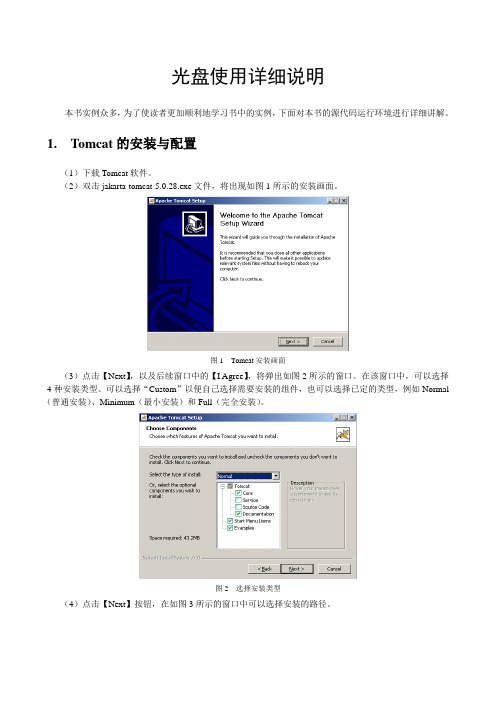
光盘使用详细说明本书实例众多,为了使读者更加顺利地学习书中的实例,下面对本书的源代码运行环境进行详细讲解。
1. Tomcat的安装与配置(1)下载Tomcat软件。
(2)双击jakarta-tomcat-5.0.28.exe文件,将出现如图1所示的安装画面。
图1 Tomcat安装画面(3)点击【Next】,以及后续窗口中的【I Agree】,将弹出如图2所示的窗口。
在该窗口中,可以选择4种安装类型。
可以选择“Custom”以便自己选择需要安装的组件,也可以选择已定的类型,例如Normal (普通安装)、Minimum(最小安装)和Full(完全安装)。
图2 选择安装类型(4)点击【Next】按钮,在如图3所示的窗口中可以选择安装的路径。
图3 选择安装路径(5)继续点击【Next】按钮,在出现的“配置”窗口中可以设定服务器的端口(这里将端口设为80)、管理员登录的用户名和密码,如图4所示。
图4 设置服务器端口、管理员用户名、密码(6)点击【Next】按钮,在出现的窗口中选择Tomcat运行所依赖的JDK,如图5所示。
最后点击【Install】完成安装。
图5 选择运行时所依赖的JDK(7)除了按照上面的步骤安装Tomcat以外,还需要设置JA V A_HOME、CA TALINA_HOME两个环境变量,它们分别对应JDK的安装目录和Tomcat的安装目录。
例如,JDK安装在F:\Java目录下,Tomcat 安装在F:\Tomcat目录下,那么JA V A_HOME=F:\Java,CATALINA_HOME= F:\Java。
2. JBoss的安装与配置JBoss是纯Java的Web应用服务器,为了保证JBoss服务器的正常运行,在安装JBoss之前首先要确保系统已经安装了JDK。
可以从下载JBoss,目前JBoss的最新版本是4.0.3RC2,在这里使用比较稳定的4.0.1版本。
JBoss的配置与运行步骤如下。
Eclipse使用方法介绍
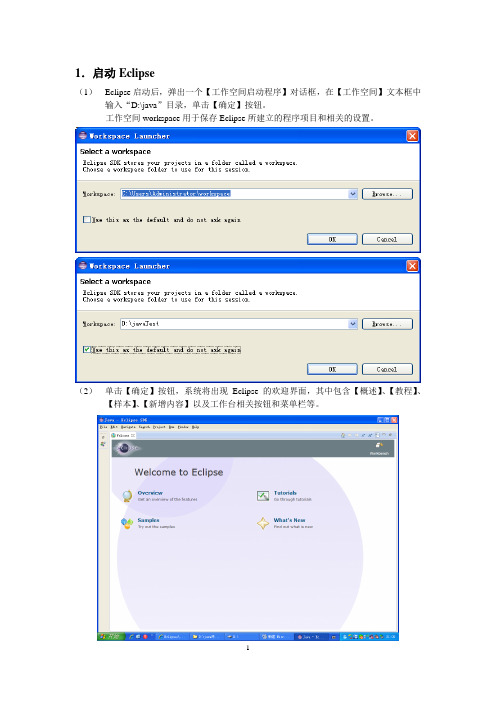
(1)Eclipse启动后,弹出一个【工作空间启动程序】对话框,在【工作空间】文本框中输入“D:\java”目录,单击【确定】按钮。
工作空间workspace用于保存Eclipse所建立的程序项目和相关的设置。
(2)单击【确定】按钮,系统将出现Eclipse的欢迎界面,其中包含【概述】、【教程】、【样本】、【新增内容】以及工作台相关按钮和菜单栏等。
在Eclipse的欢迎界面中,单击【工作台】按钮或者关闭【欢迎】的界面窗口,将显示出Eclipse的工作台,包括标题栏、菜单栏、工具栏、编辑器、透视图和相关的视图。
3.Eclipse菜单栏(1)文件菜单包含【新建】、【保存】、【关闭】以及【刷新】等命令,主要用于新项目的创建、保存以及关闭等操作。
(2)编辑菜单主要用于辅助程序设计代码设计工作、如代码的【复制】、【剪贴】和【粘贴】等。
(3)源代码菜单包含的命令都是和代码编写相关的,主要用于复制编程工作。
(4)重构菜单是Eclipse最为关键的菜单,主要包括对项目重构的相关命令,需重点掌握。
(5)项目菜单用于管理Eclipse中的项目,用于项目的打开与关闭、自动构建等操作。
(6)运行菜单包含了与程序运行和调试相关的各种操作,同时还具有保存运行和调试的记录功能。
(7)窗口菜单用于显示、隐藏或处理Eclipse中的各种视图和透视图。
4.Eclipse中创建Java项目在Eclipse中编写应用程序时,需要先创建一个项目。
Eclipse的多种项目中,其中Java 项目是用于管理和编写Java程序的。
(1)创建一个java项目(2)新建一个类文件5.在代码编辑器中编写并运行Java程序代码编辑器的使用技巧(1)自动导入程序中用到的类:Ctrl+Shift+O(2)自动补全代码:Alt+/Alt + / 具有代码提示、自动补全的功能能够帮助我们在开发的时候,如果忘了某个类的全名,只需要输入开头的几个字母,然后用alt+/出来就可以了,帮助实现快速开发的。
Eclipse-简明教程(全)

Data –开始
Data –开始
方案基本定义数据段:标题,开始的时间 油藏描述数据段:厚度、孔渗 流体性质数据段:高压物性 岩石—流体数据段:相渗曲线、毛管压力 油藏初始条件数据段:油气水界面、水区 分区数据段 井数据段:井位、完井位置、井史 输出控制段 敏感性分析
81
82
Data –开始
FloGrid 模块
--File containing the deviation data FILE “ well. dev " END
FloGrid
WELLNAME: 'PROD1' 554378.2 6805876 554378.2 6805876 554378.2 6805876 554378.2 6805876 554378.2 6805876 554378.2 6805876 554378.2 6805876 554378.2 6805876
FloGrid
一. 导 入 数 据
12
FloGrid
一. 导 入 数 据
13
FloGrid
一. 导 入 数 据
14
FloGrid
一.
导
入 数
Import Contour Maps
据
X Y Property
79.0 6500 3016 100. 6489 3016 200. 6431 3016
建 立 网 格 模 型
角 点
46
FloGrid
三. 建 立 地 质 模 型
建 立 网 格 模 型
角 点
47
FloGrid
三. 建 立 地 质 模 型
建 立 网 格 模 型
块 中 心
Eclipse使用手册
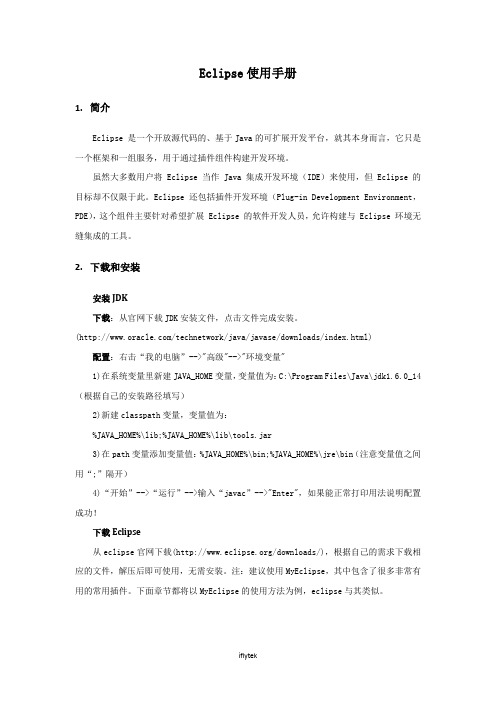
Eclipse使用手册1.简介Eclipse 是一个开放源代码的、基于Java的可扩展开发平台,就其本身而言,它只是一个框架和一组服务,用于通过插件组件构建开发环境。
虽然大多数用户将 Eclipse 当作 Java 集成开发环境(IDE)来使用,但 Eclipse 的目标却不仅限于此。
Eclipse 还包括插件开发环境(Plug-in Development Environment,PDE),这个组件主要针对希望扩展 Eclipse 的软件开发人员,允许构建与 Eclipse 环境无缝集成的工具。
2.下载和安装安装JDK下载:从官网下载JDK安装文件,点击文件完成安装。
(/technetwork/java/javase/downloads/index.html) 配置:右击“我的电脑”-->"高级"-->"环境变量"1)在系统变量里新建JAVA_HOME变量,变量值为:C:\Program Files\Java\jdk1.6.0_14(根据自己的安装路径填写)2)新建classpath变量,变量值为:%JAVA_HOME%\lib;%JAVA_HOME%\lib\tools.jar3)在path变量添加变量值:%JAVA_HOME%\bin;%JAVA_HOME%\jre\bin(注意变量值之间用“;”隔开)4)“开始”-->“运行”-->输入“javac”-->"Enter",如果能正常打印用法说明配置成功!下载Eclipse从eclipse官网下载(/downloads/),根据自己的需求下载相应的文件,解压后即可使用,无需安装。
注:建议使用MyEclipse,其中包含了很多非常有用的常用插件。
下面章节都将以MyEclipse的使用方法为例,eclipse与其类似。
运行Eclipse打开MyEclipse的解压目录,找到其中的myeclipse.exe,双击运行MyEclipse。
Eclipse 使用说明书
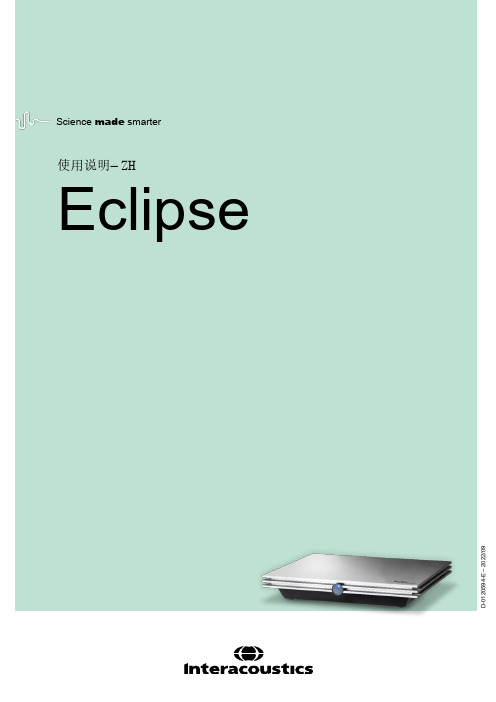
Copyright© Interacoustics A/S:版权所有。
本文档中的信息归 Interacoustics⅍专有。
本文档中的信息如有更改,恕不另行通知。
未经 Interacoustics A/S事先书面许可,不得以任何方式或手段复制或传播本文档的任何部分。
目录1简介 (1)1.1关于本手册 (1)1.2使用说明 (2)1.2.1预期的操作人员 (2)1.2.2患者人群 (2)1.2.3禁忌症 (2)1.3产品说明 (3)1.4警告 (4)1.5故障 (5)2开箱和安装 (6)2.1检查 (6)2.2标记 (7)2.3硬件安装 (8)2.3.1将病床 /椅子放在地上 (9)2.3.2Eclipse 后面板 (10)2.3.3Eclipse前部面板 (10)2.3.4前置放大器按钮 (11)2.4软件安装 (11)2.4.1安装前须知 (11)2.4.2计算机系统最低要求 (11)2.4.3所需材料: (12)2.4.4软件安装 (12)2.4.5驱动程序安装 (13)2.4.6恢复软件出厂默认设置 (13)2.4.7安装语言包 (13)2.5识读台 (15)2.6许可证 (15)2.6.1Eclipse序列号 (15)2.6.2DSP序列号和许可证密钥 (15)2.7从 OtoAccess® 数据库启动 (16)2.7.1OtoAccess® 数据库中的模块设置 (16)2.8从Noah启动(仅 ASSR 或 IA OAE Suite) (17)3EP15/EP25操作说明 (18)3.1记录标签 (19)3.1.1主菜单项 (19)3.1.2电子帮助 (20)3.1.3查看历史会话 (20)3.1.4协议选择 (20)3.1.5临时设置 (20)3.1.6重新排列曲线 (20)3.1.7波形分组 (20)3.1.8报告 (20)3.1.9打印 (21)3.1.10显示A-B曲线 (21)3.1.11显示对侧曲线 (21)3.1.12授话 (21)3.1.13单曲线显示 (21)3.1.14分屏显示 (22)3.1.15保存并新建 (22)3.1.16保存并退出 (22)3.1.17刺激率选择 (22)3.1.18频率选择 (23)3.1.19刺激窗口 (23)3.1.20手动刺激窗口 (23)3.1.21状态窗口 (23)3.1.22波形再现性 (24)3.1.23开始/停止 (24)3.1.24暂停 (24)3.1.25下一强度 (24)3.1.26Fmp与残留噪声曲线图 (24)3.1.27扫描数/平均数的扩展 (25)3.1.28原始EEG (25)3.1.29高级EEG (25)3.1.30隐藏刺激伪影 (26)3.1.31显示增益 (27)3.1.32记录窗口 (27)3.1.33选择波形 (27)3.1.34移动单条曲线 (27)3.1.35显示微分曲线 (27)3.1.36为波形增添一条注释 (28)3.1.37拒收监测 (29)3.1.38放置波形标记 (29)3.1.39删除波形标记 (29)3.1.40建议波形标记 (30)3.1.41标准化潜伏期数据 (30)3.1.42删除单条曲线 (30)3.1.43放大/缩小单条曲线 (30)3.1.44隐藏单条曲线 (31)3.1.45固定单条曲线/与历史会话进行比较 (31)3.1.46合并曲线(创建加总曲线) (31)3.1.47添加曲线 (32)3.1.48同侧减对侧差值(Ipsi-Contra)曲线 (32)3.1.49A减B差值(A-B(N))曲线 (32)3.1.50修改显示滤波 (33)3.1.51记录的曲线状况 (33)3.1.52向曲线添加备注 (33)3.1.53使用光标 (34)3.1.54信噪比计算(3:1) (34)3.1.55CR、RA和INC波形标记 (34)3.2潜伏期标签 (35)3.2.1潜伏期值 (35)3.2.2潜伏期间值 (35)3.2.3潜伏期曲线图 (36)3.2.4显示波峰至波谷标记(SN10标记)(仅EPx5软件) (37)3.3Windows® 8, 10 和 11 无法启动帮助 (37)3.4电脑快捷键 (38)3.5测试前患者准备 (39)3.5.1阻抗检查 (39)3.5.2换能器 (39)3.6进行ABR阈值记录 (40)3.6.1电极画面 (40)3.6.2ABR阈值刺激 (40)3.6.3编辑ABR阈值记录 (41)3.6.4使用ABR阈值结果说明 (41)3.7进行神经潜伏期记录 (42)3.7.1电极画面 (42)3.7.2编辑神经潜伏期记录 (42)3.8进行eABR记录 (44)3.8.1两个推荐eABR电极画面 (44)3.8.2编辑eABR记录 (44)3.8.3电气阈值估算(用于人工耳蜗安接) (45)3.9进行ECochG记录 (46)3.9.1ECochG 电极安装 (46)3.9.2编辑ECochG记录 (48)3.10进行CM记录 (49)针对患者的准备工作至关重要 (49)3.10.1CM电极画面 (49)3.10.2用于CM记录的刺激 (49)3.10.3CM记录示例 (49)3.10.4CM结果内差值 (49)3.11进行AMLR记录 (50)3.11.1电极画面AMLR示例 (50)3.11.2可用AMLR刺激 (50)3.11.3AMLR记录示例 (51)3.12进行ALR记录/皮层ERA (52)3.12.1ALR阈值记录的电极画面示例 (52)3.12.2刺激信号 (52)3.12.3ALR结果说明 (53)3.12.4电生理阈值估算和婴幼儿听力仪器安接 (53)3.13进行P300/MMN记录 (54)3.13.1P300/MMN电极画面示例 (54)3.13.2可用P300/MMN刺激 (54)3.13.3P300和MMN参数汇总表 (55)3.14性能/环回(LBK15)测试 (55)4VEMP操作说明 (56)4.1前置放大器设置 (56)4.2VEMP监示器 (56)4.3VEMP波形标记 (57)4.4计算VEMP不对称率(VEMP伙伴) (57)4.5VEMP比例设定 (58)4.6进行cVEMP记录 (58)4.6.1用于cVEMP的电极画面 (58)4.6.2用于cVEMP的刺激 (59)4.6.3默认收集参数 (59)4.6.4程序 (59)4.6.5编辑cVEMP结果 (59)4.6.6cVEMP结果示例 (60)4.6.7cVEMP结果示例 (60)4.7进行oVEMP记录 (61)4.7.1oVEMP电极画面 (61)4.7.2用于oVEMP的刺激 (61)4.7.3默认收集参数 (61)4.7.4程序 (62)4.7.5oVEMP结果示例 (62)5研究模块 (63)5.1.1记录每次扫描(以便以后进行“中继”) (63)5.1.2导出平均曲线和/或完整会话 (64)5.1.3导出会话(所有曲线) (65)5.1.4离线导出波形 (65)5.1.5导入用于刺激的波形文件 (65)6操作说明 (69)6.1耳塞的操作和选择 (69)6.2OAE 设备的日常系统检查 (70)6.2.1探头完整性测试 (70)6.2.2真耳检查 (71)7.IA OAE Suite (72)7.1PC 电源配置 (72)7.2兼容的设备 (72)7.2.1从 OtoAccess® 数据库启动 (72)7.2.2从 Noah 4 启动 (72)7.2.3模拟模式 (72)7.2.4崩溃报告 (73)7.3使用菜单 (74)7.4使用 DPOAE 探头 (75)7.4.1准备测试 (75)7.4.2DPOAE 模块中的元素 (77)7.5使用 TEOAE 模块 (83)7.5.1准备测试 (83)7.5.2TEOAE 模块中的元素 (85)7.6使用打印向导 (90)8.ABRIS操作说明 (92)8.1使用ABRIS模块 (92)8.2安装电极 (92)8.3阻抗检查 (92)8.4回路(LBK15)测试 (93)8.5ABRIS测试屏幕 (93)8.5.1主菜单项 (93)8.5.2查看历史会话 (94)8.5.3保存并退出 (94)8.5.4打印 (94)8.5.5电子帮助 (94)8.5.6报告 (94)8.5.7查看EEG或噪声条 (94)8.5.8刺激窗口 (94)8.5.9测试状态窗口 (95)8.5.10受试耳 (95)8.6进行ABRIS记录 (96)8.6.1开始与暂停测试 (96)8.6.2EEG曲线图 (96)8.6.3EEG噪声条 (96)8.6.4AEP波形 (96)8.6.5备注框 (96)8.6.6状态栏 (97)8.6.7ABRIS反应曲线 (97)8.7电脑快捷键 (98)8.8可拆卸零部件 (98)9.ASSR操作说明 (99)9.1使用ASSR模块 (99)9.2ASSR测试前准备 (99)9.3测试前准备 (99)9.3.1皮肤准备 (99)9.3.2放置电极 (100)9.3.3阻抗检查 (100)9.4安装电极 (101)9.5阻抗检查 (101)9.6系统性能/回路(LBK15)测试 (101)9.7ASSR标签 (102)9.7.1主菜单项 (102)9.7.2协议选择 (102)9.7.3临时设置 (103)9.7.4报告 (103)9.7.5打印 (103)9.7.6保存并退出 (103)9.7.7查看历史会话 (103)9.7.8刺激窗口 (103)9.7.9总会话状态窗口 (104)9.7.10刺激率 (104)9.8进行ASSR记录 (105)9.8.1开始/停止 (105)9.8.2暂停 (105)9.8.3原始EEG曲线图 (105)9.8.4测试频率曲线图 (105)9.8.5CM 检测器 (106)9.8.6ASSR表 (106)9.8.7延长测试时间 (107)9.8.8调整刺激强度 (107)9.8.9中止测试频率/强度 (108)9.8.10ASSR 遮蔽计算器 (108)9.9听力图标签 (110)9.9.1估计的听力图符号 (110)9.9.2NOAH 或 OtoAccess® 数据库中的听力符号 (111)9.9.3估算听力图 (112)9.9.4AC 和 BC 在同一听力图中 (113)9.9.5无反应 (114)9.9.6选定的校正系数 (114)9.9.7电脑快捷键 (114)10.维护 (115)10.1通用维护程序 (115)10.2如何清洁国际听力产品 (115)10.3清洁OAE探头尖 (116)10.4关于维修 (117)10.5保修 (117)11.技术规格 (119)11.1技术规格 - Eclipse硬件 (119)11.2EP15/EP25/VEMP技术规格 (120)11.2.1peSPL至nHL校正值 (122)11.3TEOAE25技术规格 (123)11.4DPOAE技术规格 (124)11.5ABRIS技术规格 (125)11.6ASSR技术规格 (126)11.7电磁兼容性(EMC) (127)11.8Eclipse软件模块概览 (132)11.8.1EP15/EP25/VEMP模块 (132)11.8.2P15/EP25/VEMP模块刺激最大强度 (133)11.8.3TEOAE25模块 (134)11.8.4DPOAE模块 (134)11.8.5ABRIS模块 (134)11.8.6ASSR模块 (134)1简介1.1 关于本手册本手册适用于EP15/25 v4.6软件版本、IA OAE套件1.2、ABRIS v1.6.3、VEMP v4.6和ASSR v 1.3。
eclipse中文教程

eclipse中文教程Eclipse是一个广泛使用的Java集成开发环境(IDE),被许多开发者用来编写Java应用程序。
本文将为您介绍Eclipse的基本功能以及如何使用它来进行Java开发。
首先,让我们来了解一下Eclipse的安装和配置。
您可以从Eclipse官方网站上下载Eclipse的最新版本。
安装完成后,您需要配置Java环境变量,以便Eclipse可以找到JDK并正常运行。
配置好环境变量后,您可以启动Eclipse。
一旦您启动了Eclipse,您将看到一个欢迎页面。
在这个页面上,您可以选择创建一个新的Java项目或导入现有的项目。
要创建一个新的Java项目,您需要选择“新建”按钮并选择“Java项目”。
在项目创建向导中,您需要输入项目的名称和存储位置。
一旦您完成了这些步骤,您的项目将会在Eclipse的项目资源管理器中显示出来。
在Eclipse中编写Java代码非常简单。
您只需双击项目资源管理器中的“src”文件夹,然后选择“新建Java类”来创建一个新的Java类。
在类编辑器中,您可以编写您的Java代码。
Eclipse提供了许多功能,如代码自动完成功能、错误检查和自动补全等,以帮助您更高效地编写代码。
除了编写Java代码外,Eclipse还提供了调试功能,可以帮助您定位和解决代码中的错误。
您可以设置断点并逐行执行代码,观察变量的值,以及查看代码的调用栈。
这些调试功能可以帮助您更好地理解代码的执行过程,并找到潜在的问题。
另一个强大的功能是Eclipse的插件系统。
通过安装插件,您可以将Eclipse扩展为适用于其他编程语言或框架的开发环境。
Eclipse插件社区很活跃,可以找到许多有用的插件,如用于Android开发的ADT插件、用于Web开发的WTP插件等。
除了Java开发外,Eclipse还支持其他编程语言的开发,如C/C++、Python和PHP等。
要使用Eclipse进行其他语言的开发,您需要安装相应的插件,并对项目进行适当的配置。
eclipse操作说明书(带参数设置)
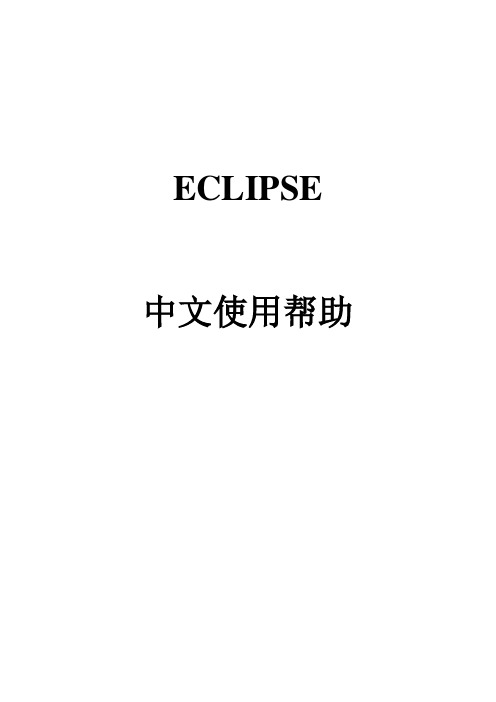
ECLIPSE 中文使用帮助一、新建工程打开officeFile/new project;取名 example单击Data,打开对话框(一)单击 case definition,打开对话框Black oil(黑油模型);组分模型;热采;再这个界面上,1、选择general:输入模拟开始时间,模型定义:网格数X*Y*Z;(可以通过petrel里面的统计功能查看)单位(units):field,Metric,Lab2、选择reservoir定义网格类型Grid type:Cartesian;Radial定义geometry type:Block centered;Corner point3、点击PVT界面选择流体类型:gas/oil/water 4、其他几个选项:点击OK,返回data模块(二)点击Grid,打开grid section如下对话框选择File菜单,再选择Import File选项将petrel建的模型导入。
从菜单项中打开,subsection/grid keyword,打开grid keywords section1、选择keywords type: PropertiesInsert keyword:PERMX;PERMY;PERMZ;NTG;PORO;单击Apply2、选择keywords type: GeometryInsert keyword:DX;DY;DZ;TOPS3、选择keywords type: Operational keywordsInsert keyword:NORCHO;SAVE;RPTGRID;INIT 4、可以选择水体等等。
5、单击close。
Grid View中Run Simulation运算后观看6、file/save file7、具体参数设置例子如下:(四)打开PVT模块从这个模块中输入流体参数,组分模型应该再PVT模块下进行组分模拟。
输入 dead oil PVT PropertiesRock PropertiesFluid Dandifies at surface conditions流体、岩石等参数例子如下:(五)打开SCAL模块。
Eclipse的使用
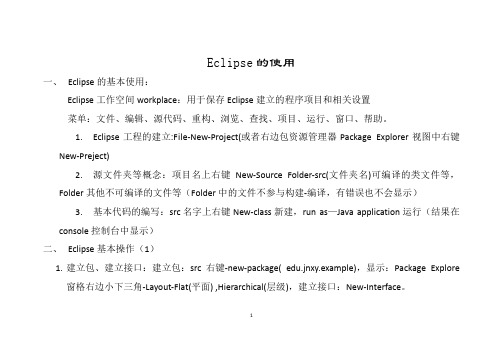
Eclipse的使用一、Eclipse的基本使用:Eclipse工作空间workplace:用于保存Eclipse建立的程序项目和相关设置菜单:文件、编辑、源代码、重构、浏览、查找、项目、运行、窗口、帮助。
1.Eclipse工程的建立:File-New-Project(或者右边包资源管理器Package Explorer视图中右键New-Preject)2.源文件夹等概念:项目名上右键New-Source Folder-src(文件夹名)可编译的类文件等,Folder其他不可编译的文件等(Folder中的文件不参与构建-编译,有错误也不会显示)3.基本代码的编写:src名字上右键New-class新建,run as—Java application运行(结果在console控制台中显示)二、Eclipse基本操作(1)1.建立包、建立接口:建立包:src右键-new-package( edu.jnxy.example),显示:Package Explore窗格右边小下三角-Layout-Flat(平面) ,Hierarchical(层级),建立接口:New-Interface。
12.工程的配置:项目名上右键-propertier::Java Build(构建-编译) Path-Source(设置构建源文件夹,可以添加、编辑、移除) ,Libraries(Add External Jars添加第三方jar包,Add Jars添加Project中Folder中已有的jar包)。
3.工程的构建:文件保存时默认自动构建,所以运行时很快(与命令行编译运行相比),可以点击Preject-Build Automatically去掉自动构建,Project-Clean可以删除所有class文件,然后自动重新构建(可选所有项目或者选择的项目)。
三、Eclipse常用技巧1.对象、类名输入点后,自动出现字段、方法名:1)代码完成功能—Alt+/,Ctrl+Alt+/自动补全关键字2)代码格式化功能:选中要可视化的代码,按Ctrl+Shift+F格式化代码。
Eclipse使用手册
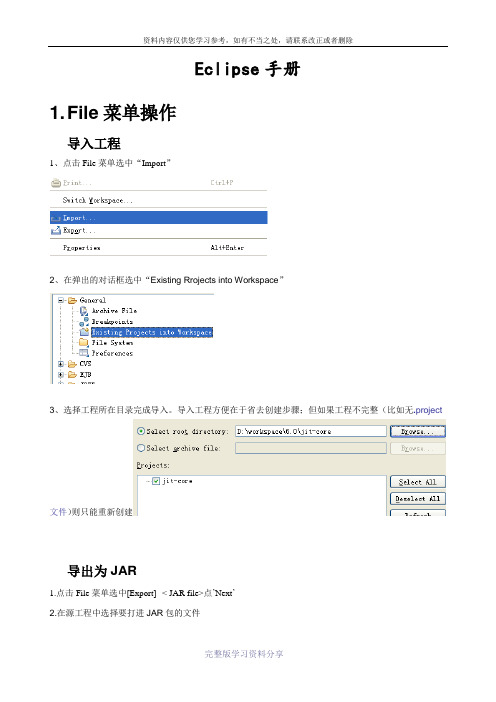
Eclipse手册1. File菜单操作导入工程1、点击File菜单选中“Import”2、在弹出的对话框选中“Existing Rrojects into Workspace”3、选择工程所在目录完成导入。
导入工程方便在于省去创建步骤;但如果工程不完整(比如无.project 文件)则只能重新创建导出为JAR1.点击File菜单选中[Export]--< JAR file>点’Next’2.在源工程中选择要打进JAR包的文件3.选中‘Export .......’中的一种或多种,第一个表示对类文件.class打包,第二个表示将整个工程文件(无java文件),第三个表示将类.java文件打包。
‘Select the export destination:’选择打包到哪个目录,点击‘Finish’即可导出工程1.选择工程项目右键执行Export。
弹出下图2.选择File System点击Next到下图,此举可以避免将svn之类文件导出2. Window菜单操作Show View项目显示的格式,Eclipse中项目树形显示常用形式如下:1、总树分支式使用[window]--<show view>--<Navigator>2、分支式使用[window]--<show view>--<Package Explorer>3、Declaration显示Windows --> Show View -- > Declaration:选中代码中的一个方法, 然后按这个按键,它会把整个方法在申明方框里显示出来。
如下选中了类中的execute方法,则下方的Declaration将这个方法显示出来Preferences高亮Windows->Preferences->Java-> Editor-> Mark Occurrences,勾选选项。
eclipse使用说明
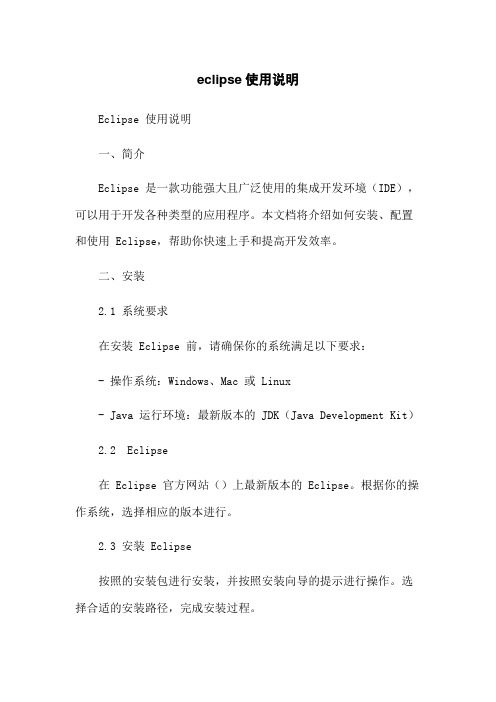
eclipse使用说明Eclipse 使用说明一、简介Eclipse 是一款功能强大且广泛使用的集成开发环境(IDE),可以用于开发各种类型的应用程序。
本文档将介绍如何安装、配置和使用 Eclipse,帮助你快速上手和提高开发效率。
二、安装2.1 系统要求在安装 Eclipse 前,请确保你的系统满足以下要求:- 操作系统:Windows、Mac 或 Linux- Java 运行环境:最新版本的 JDK(Java Development Kit)2.2 Eclipse在 Eclipse 官方网站()上最新版本的 Eclipse。
根据你的操作系统,选择相应的版本进行。
2.3 安装 Eclipse按照的安装包进行安装,并按照安装向导的提示进行操作。
选择合适的安装路径,完成安装过程。
三、配置3.1 设置工作区当首次启动 Eclipse 时,系统会提示你选择工作区。
工作区是Eclipse 存储你的项目和配置信息的地方。
选择一个适合的目录作为你的工作区,并“OK”按钮。
3.2 配置 JDK在 Eclipse 中,需要事先配置好 Java 运行环境(JRE 或JDK)。
打开 Eclipse 后,依次“Window”->“Preferences”->“Java”->“Installed JREs”,然后“Add”按钮,选择你的 JDK 安装路径,“OK”按钮保存配置。
3.3 添加插件Eclipse 支持通过安装插件的方式扩展功能。
“Help”->“Eclipse Marketplace”,在弹出的窗口中搜索你需要的插件,然后按照安装提示进行安装。
四、基本操作4.1 创建项目在 Eclipse 左侧的导航栏中,右键“Project Explorer”视图,选择“New”->“Java Project”,输入项目名称并“Finish”按钮。
4.2 编写代码在创建好的项目上,右键“src”目录,选择“New”->“Class”,输入类名和所在包名,并“Finish”按钮。
eclipse-plugin 插件使用说明说明书

Table of ContentsAbout1 Chapter 1: Getting started with eclipse-plugin2 Remarks2 Examples2 Installation or Setup2 Hello World4 Credits14AboutYou can share this PDF with anyone you feel could benefit from it, downloaded the latest version from: eclipse-pluginIt is an unofficial and free eclipse-plugin ebook created for educational purposes. All the content is extracted from Stack Overflow Documentation, which is written by many hardworking individuals at Stack Overflow. It is neither affiliated with Stack Overflow nor official eclipse-plugin.The content is released under Creative Commons BY-SA, and the list of contributors to each chapter are provided in the credits section at the end of this book. Images may be copyright of their respective owners unless otherwise specified. All trademarks and registered trademarks are the property of their respective company owners.Use the content presented in this book at your own risk; it is not guaranteed to be correct nor accurate, please send your feedback and corrections to ********************Chapter 1: Getting started with eclipse-plugin RemarksThis section provides an overview of what eclipse-plugin is, and why a developer might want to use it.It should also mention any large subjects within eclipse-plugin, and link out to the related topics. Since the Documentation for eclipse-plugin is new, you may need to create initial versions of those related topics.ExamplesInstallation or SetupAssuming you have Eclipse IDE for Java Developers installed, start Eclipse, click "Help" -> "Install New Software..."Select "--All Available Sites--" at "Work with:", and navigate to "Eclipse Plugin Development Tools ". Select "Eclipse Plug-in Development Environment" by ticking the checkbox in front of it.Click "Next" to let Eclipse check for any dependencies needed. Click "Next" again to start the installation.Once that has finished, restart Eclipse.Hello WorldTo create a Hello World plug-in for Eclipse, click: File ➜ New ➜ Other...Select Plug-in Project and click Next >The New Plug-in Project wizard will guide you through the options for creating a new plug-in. Enter a project name (like HelloWorld), and click Next >On the Content page, you can set the ID, Version, Name and Vendor of the plug-in.The Version will be 1.0.0.qualifier by default. You can leave this as-is, but it is better to change this to something meaningful. The eclipse wiki recommends a syntax like vYYYYMMDD (year, month day).On the Templates page, you can choose to create you plug-in from any template by selecting it and clicking Next >. Alternatively you can combine these templates by choosing Custom plug-in wizard, or to create a new plug-in without a template by deselecting the checkbox in front of Create a plug-in using one of the templates.For the Hello, World Command template, there are additional settings: the package name, Handler class name and the text for the message box.When the plug-in is created, you can run it by right-clicking the plugin.xml ➜ Run As ➜ Eclipse ApplicationThis will launch a new instance of Eclipse (with its own workspace) that will have your plug-in loaded.This Hello World plug-in will have made 3 contributions to the Eclipse GUI:1. A Sample Menu (with Sample Command):Plugin.xml:point="org.eclipse.ui.menus"><menuContributionlocationURI="menu:org.eclipse.ui.main.menu?after=additions"><menulabel="Sample Menu"mnemonic="M"id="HelloWorld.menus.sampleMenu"><commandcommandId="mands.sampleCommand"mnemonic="S"id="HelloWorld.menus.sampleCommand"></command></menu></menuContribution></extension>2. A toolbar icon:Plugin.xml:<extensionpoint="org.eclipse.ui.menus"><menuContributionlocationURI="toolbar:org.eclipse.ui.main.toolbar?after=additions"> <toolbarid="HelloWorld.toolbars.sampleToolbar"><commandcommandId="mands.sampleCommand"icon="icons/sample.gif"tooltip="Say hello world"id="HelloWorld.toolbars.sampleCommand"></command></toolbar></menuContribution></extension>3. A key shortcut (Ctrl+6)Plugin.xml:<extensionpoint="org.eclipse.ui.bindings"><keycommandId="mands.sampleCommand"contextId="org.eclipse.ui.contexts.window"sequence="M1+6"schemeId="org.eclipse.ui.defaultAcceleratorConfiguration"></key>When activating any of these 3, the Handler class will be executed:Plugin.xml:<extensionpoint="mands"><categoryname="Sample Category"id="mands.category"></category><commandname="Sample Command"categoryId="mands.category"id="mands.sampleCommand"></command></extension><extensionpoint="org.eclipse.ui.handlers"><handlercommandId="mands.sampleCommand"class="helloworld.handlers.SampleHandler"></handler></extension>SampleHandler.java:package helloworld.handlers;import mands.AbstractHandler;import mands.ExecutionEvent;import mands.ExecutionException;import org.eclipse.ui.IWorkbenchWindow;import org.eclipse.ui.handlers.HandlerUtil;import org.eclipse.jface.dialogs.MessageDialog;/*** Our sample handler extends AbstractHandler, an IHandler base class.* @see mands.IHandler* @see mands.AbstractHandler*/public class SampleHandler extends AbstractHandler {@Overridepublic Object execute(ExecutionEvent event) throws ExecutionException {IWorkbenchWindow window = HandlerUtil.getActiveWorkbenchWindowChecked(event); MessageDialog.openInformation(window.getShell(),"HelloWorld","Hello, Eclipse world");return null;}}When the Handler class is executed, MessageBox will show:This is all the Hello World plug-in does.If you want to create a plug-in with more functionality, you could have chosen a template that best fits your need or create a plug-in via the Custom plug-in wizard to combine these templates:Read Getting started with eclipse-plugin online: https:///eclipse-plugin/topic/4982/getting-started-with-eclipse-pluginCredits。
Eclipse Model 2220 SE 箭头板操作手册及配件指南说明书

REVISED OCTOBER 2010ECLIPSEMODEL 2220/SEOPERATOR ANDPARTS MANUALALLMAND BROTHERS INC.P.O. BOX 888HOLDREGE, NE 68949PART NO. 103410PHONE: (308) 995- 4495, 1- 800- 562- 1373ALLMAND FAX: (308) 995– 5887ALLMAND PARTS DEPT. FAX : (308) 995– 4883 ECLIPSE MODEL 2220/SEECLIPSE 2220/SE BLANK PAGELimited Warranty Arrowboard Addendum 4/08ARROWBOARD LIMITED WARRANTY ADDENDUMTHIS WARRANTY ADDENDUM IS IN ADDITION TO THE BASIC ALLMANDLIMITED WARRANTY OF THREE (3) YEARS AFTER DELIVERY TO THEORIGINAL PURCHASER.Subject to the foregoing the manufacturer, Allmand Bros. Inc. hereby warrants thefollowing components manufactured by Allmand Bros. Inc., to be free from defects inmaterial and workmanship from date of manufacture for the following:No representative, dealer or distributor of the company is authorized to make any changesor exceptions to this warranty unless expressly authorized in writing from themanufacturer. All warranty claims must be filed within thirty (30) days of failure.Please call the Allmand Service and Warranty Department for specific manufacturer’swarranty terms and schedules. All warranties subject to change without notice.Allmand Bros. Inc. PO Box 888 1502 West 4th Ave Holdrege, NE 68949 800-562-1373 / 308-995-4495 Fax 308-995-5887 / ECLIPSE 2220/SE BLANK PAGEREVISED APRIL 2011NOTE: NS = NOT SHOWN. WHEN ORDERING, SPECIFY THE COLOR WANTED ON PARTS CONTAINING THE LETTER “P”.NOTE: NS = NOT SHOWN. WHEN ORDERING, SPECIFY THE COLOR WANTED ON PARTS CONTAINING THE LETTER “P”.JACK STANDSECLIPSE 2220/SE 3/17/2011BOLT ON JACK STANDS (OPTIONAL)ECLIPSE 2220/SE 3/17/2011FENDERSECLIPSE 2220/SE 3/17/2011ON BOARD BATTERY CHARGER OPTIONECLIPSE 2220/SE 3/17/2011BATTERY HOOD & COVERECLIPSE 2220/SE 3/17/2011TRUNK LID & BATTERY SEPERATOR OPTIONECLIPSE 2220/SE 3/17/2011WINCHECLIPSE 2220/SE 3/17/2011 NS - 712533 CABLE ASSEMBLY 3/16 X 180TAIL LIGHTSECLIPSE 2220/SE 3/17/2011HOOD LATCH & PINSECLIPSE 2220/SE 3/17/2011SWING ARMECLIPSE 2220/SE 3/17/2011DOUBLE SOLAR PANEL LIFTECLIPSE 2220/SE 3/17/2011SIGN FRAME AND REAR PANELECLIPSE 2220/SE 3/17/2011ALT 15 LIGHT LED FRONT PANELECLIPSE 2220/SE 3/17/2011APF 25 LED FRONT PANELECLIPSE 2220/SE 3/17/2011SIGN BOARD HARDWAREECLIPSE 2220/SE 3/17/2011。
Eclipse使用介绍
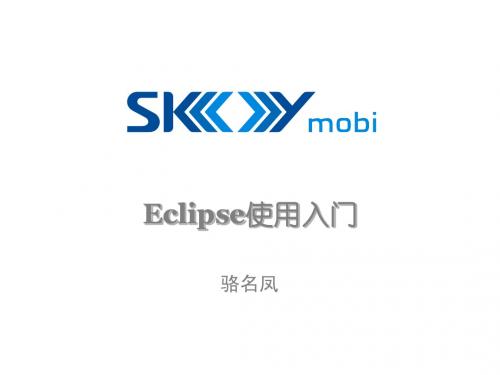
9.编译和运行
2.选中Arguments,在Program arguments输入框中输入参数;
10.调式程序
1.设置断点调试:双击需设置断点的行的左边框 2. RunDebug AsJava Application
10.调式程序
10.调式程序
1.调式程序的技巧:
F5 单步跳入 (方法中) F6 单步跳过 (一行行向下执行,不进入方法内部) F7 单步返回 (从方法中返回) F8 继续 跳到下一个断点 鼠标移至某一变量,则会显示该变量当前的值 在右上角Variables的显示框查看各变量的变化情况 在Expressions显示框中,输入表达式查看计算结果
5.使用自己的JDK
1.进入 Window > Preferences > Java
6.设置编译器版本
1.进入 Window > Preferences > Java
7.创建一个新工程
1.Filenewproject JavaProject
或Filenewproject Project
程在移植的时候不用重新引用外部类库。
16.文件的导入
1.导入的文件不是一个工程(项目): fileimport 或 工程/包上右键,import
16.文件的导入
2.点next,选择文件所在目录,然后在弹出的视图中选中要导入的文件,点击
finish完成导入。
16.文件的导入
3.导入的文件是一个工程, fileimport
2.Eclipse环境的搭建
1. Eclipse下载
2. Eclipse安装 3. JDK安装,环境变量配置
JAVA_HOME=JDK安装路径 PATH=…;%JAVA_HOME%\bin
ECLIPSE用户手册(全文上载)
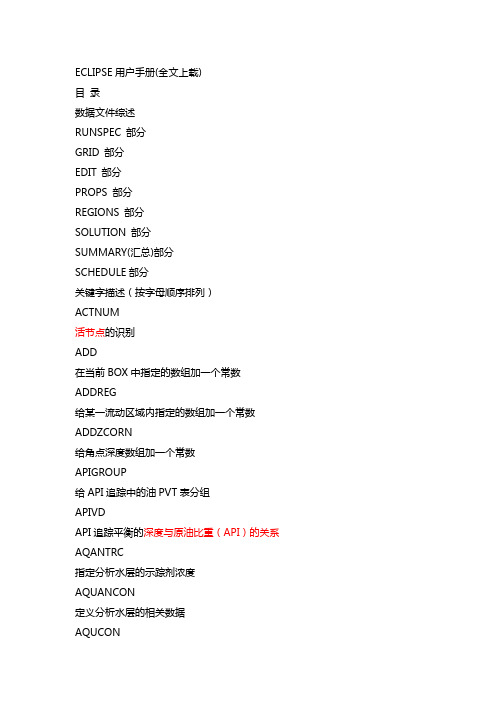
ECLIPSE用户手册(全文上载)目录数据文件综述RUNSPEC 部分GRID 部分EDIT 部分PROPS 部分REGIONS 部分SOLUTION 部分SUMMARY(汇总)部分SCHEDULE部分关键字描述(按字母顺序排列)ACTNUM活节点的识别ADD在当前BOX中指定的数组加一个常数ADDREG给某一流动区域内指定的数组加一个常数ADDZCORN给角点深度数组加一个常数APIGROUP给API追踪中的油PVT表分组APIVDAPI追踪平衡的深度与原油比重(API)的关系AQANTRC指定分析水层的示踪剂浓度AQUANCON定义分析水层的相关数据AQUCON数值化水层与油藏的连接AQUCT说明Carter-Tracy水层的特征数据AQUFETTetkovich 水层的特征数据AQUFETP说明Fetkovich 水层的特征数据AQUNUM给一个网格块赋值一个数值化水层AQUTABCarter-Tracy水层的影响函数表BDENSITY盐水地面密度BOUNDARY定义在打印网格表中显示的网格范围BOX重新定义当前输入的BOXCECON生产井射开节点的经济极限COLLAPSE识别在压缩VE选择中可压塌的单元COLUMNS设臵输入数据文件的左右范围COMPDAT井完井段说明数据COMPFLSH井射孔段的闪蒸转化比COMPIMB井射开网格的渗吸表号COMPINJK用户定义的注入井相对渗透率COMPLUMP为自动修井而将射开网格归在一起COMPRP重新标定井射开节点的饱和度数据COMPVE垂直平衡(V.E.)运行时,井射孔深度的重设定COORD坐标线COORDSYS坐标系统信息COPY从一个数组拷贝数据到另一数组COPYBOX从一个BOX向另外一个拷贝一组网络数据CRITPERM对VE节点压缩的渗透率标准DATE输出日期到汇总文件DATES模拟者事先指定报告日期DATUM基准面深度,用于深度校正压力的输出BEBUG控制检测输出DENSITY地面条件下流体密度DEPTH网块中心深度DIFFC每一个PVT区域的分子扩散数据DIFFDP在双重介质运行中,限制分子扩散DIFFMMF基质-裂缝的扩散乘子DIFFMRR方向的扩散乘子DIFFMTHTθ方向扩散系数乘子DIFFMXX方向的扩散乘子DIFFMYY方向的扩散乘子DIFFMZZ方向的扩散乘子DIFFRR方向的扩散系数DIFFTHTθ方向的扩散系数DIFFXX方向扩散系数DIFFYY方向扩散系数DIFFZZ方向扩散系数DPGRID对裂缝单元使用基质单元的网格数据DRR方向网格的大小DRSDT溶解 GOR的增加的最大速度DRVR方向网格大小(矢量)DRVDT挥发油的 OGR的增加的最大速度DTHETAθ方向的网块大小DTHETAV网格的角度大小(向量)DXX方向的网格大小DXVX方向网格大小(向量)DYY方向网格大小DYVY方向网格大小(向量)DZZ方向网格大小DZMTRX基质块的垂直尺寸DZMTRXV基质岩体块的垂直尺寸(向量)净厚度ECHO接通重复输出开关EDITNNC改变非相邻连接EHYSTR滞后作用参数和模型选择END标志SCHEDULE部分的结束ENDBOX将BOX恢复到包含全部网格ENDNUM端点标定与深度区域号ENKRVD相对渗透率端点与深度关系表ENPTVD饱和度端点与深度关系表EQLNUM平衡区号数EQUALS在目前的BOX中设臵数组为常数平衡数据评述EXTRAPMS对表的外插请求预告信息FIPNUM流体储量区域号GCONINJE对井组井/油田注入率的控制/限制GCONPRI为‚优先‛而设的井组或油田产量限制GCONPROD井组或油田的产率控制或限制GCONSALE井组或油田的售气控制产率GCONSUMP井组的气消耗率和引进率GCONTOL井组控制目标(产率)的允许差额GECON井组或油田的经济极限数据GLIFTLIM最大井组人工举升能力GRAVITY地面条件下的流体密度GRIDFILE控制几何文件网格的容量GRUPRIG给井组配臵修井设备GRUPTREE建立多级井组控制的树状结构GSEPCOND井组设臵分离器IMBNUM渗吸饱和度函数据区域IMBNUMMF基质一裂缝渗吸区域号IMPES建立IMPES求解过程INCLUDE包含数据文件名INIT要求输出初始文件INRAD径向模型的内径KRG标定气相对渗透率的端点KRNUM方向性相对渗透率表格数KRNUMMF基岩-裂缝流动饱和度表号KRO标定油相对渗透率端点KRW标定水相对渗透率端点LOAD调入一个 SAVE文件以便执行一个快速重起动MESSAGES重设臵打印和停止限定的信息MINPV设臵活动网格的最小孔隙体积MINPV建立一个有效网格的最小孔隙空间MISCNUM混合区数目MONITOR请求实时显示输出MULTIPLY当前定义区中的数组MULTRR 方向传导率乘子MULTTHTTHETA方向传导率乘子MULTXX方向传导率乘子MULTYY方向传导率乘子MULTZZ方向传导率乘子NEWTON输出迭代计数到汇总文件NEWTRAN标定使用块拐角传导率NEXTSTEP建立下一时间步最大值NNC非相邻连接的直接输入NOECHO关闭输出的响应NOGGF压缩网格几何模型文件NODPPM非双孔的渗透率乘子NOWARN压制ECLIPSE警报信息NTG厚度净毛比OILAPI初始原油API值,以便API示踪选择OLDTRAN标定块中心传导率OLDTRANR标定任意一块中心传导率OPTIONS开启特别程序选择OUTRAD径向模型外半径OVERBU岩石负载压力表PERMRR方向绝对渗透率PERMTHTθ方向绝对渗透率PERMXX方向绝对渗透率PERMYY方向绝对渗透率PERMZZ方向绝对渗透率PINCH建立尖灭层上下的连接PINCHOUT建立尖灭层上下的连接PMAX模拟中的最大压力PMISC与压力有关的可混性表PORO网格孔隙度PORV网格孔隙体积PRESSURE初始压力PRIORITY为井的优先级选项设臵系数PRVD原始压力与深度关系表PSEUDOS为PESUDO包要求输出的数据PVCO含气原油PVT性质PVDG干气的PVT性质(无挥发油)PVDO死油的PVT性质(无挥发油)PVTG湿气的PVT性质(有挥发油)PVTNUMPVT区数目PVTO活性油的PVT性质(有溶解气)PVTW水PVT性质QDRILL在钻井队列中安臵井RESTART设臵重启动RESVNUM对一给定油藏输入角点坐标数据ROCK岩石压缩系数ROCKNUM岩石压实表格区数ROCKTAB岩石压实数据表ROCKTABH滞后岩石压实数据表RPTGRID从GRID部分输出控制RPTONLY摘要输出的常规限制RPTPROPS控制PROPS部分的输出RPTREGS控制REGIONS部分的输出RPTRST输到RESTART文件的控制RPTRUNSP控制RUNSPEC部分的数据输出RPTSCHED控制SCHEDULE部分的输出RPTSMRY控制SUMARY部分的输出RPTSOL控制SOLUTION部分的输出RS初始溶解气油比RSCONST为死油设臵的一个常数R s值RSCONSTT为每一个死油PVT表设臵的一个常数Rs值RSVD用于平衡选择的Rs与深度关系表RUNSUM所需的SUMMARY数据的制表输出RV初始挥发油气比RVCONST为干气设臵的一个常数Rv值RVCONSTT为每个干气PVT表设臵一个常数Rv值RVVD用于平衡选择的Rv与深度关系表SALT初始盐浓度SALTVD用于平衡的盐浓度与深度关系SAVE用于快速重启文件而需输出的SAVE文件SCALELIM设臵饱和度表的标度限制SDENSITY在地面条件的混相气密度SEPVALS分离测试的Bo和Rs值SGAS初始气饱和度SGCR临界气饱和度的标度SGFN气体饱和度函数SGL原生气饱和度的标准SGOF气/油饱和度函数与气饱和度SGU最大气饱和度的饱和度表的标度SIGMA双重孔隙基岩-裂缝的连结SIGMAV双重孔隙度基岩-裂缝连结(向量)SLGOF气/油饱和度函数与液体饱和度SOF2油饱和度函数(2相)SOF3油饱和度参数(3相)SQGCR临界的气中含油饱和度的标度SOMGASSTONE1模型中含油饱和度最小值SOMWATSTONE1模型中最小油饱和度值SORWMIS混相残余油饱和度数表SOWCR标度临界水中含油的饱和度值SPECGRID网格特性的详细说明STOG油气表面张力与压力STONEI三相油相对渗透率模型STONE2三相油相对渗透率模型STOW油水表面张力与对应压力SWAT初始水饱和度SWATINIT标定毛管压力的初始水饱和度SWCR临界水饱和度的标度SWFN水饱和度函数SWL原生水饱和度的标定SWLPC仅对毛管压力曲线标定原生水饱和度SWOF水/油饱和度函数和对应的水饱和度SWU饱和度数表中最大的含水饱和度的标定TBLK示踪剂的初始浓度THPRES门限压力TLMIXPARTodd-Longstaff混合参数TNUM示踪剂浓度区TOPS每个网格的顶面深度TRACER被动的示踪剂名TRACTVD为示踪剂要求‚流率极限传输‛TRANRR方向的传导率TRANTHTθ方向的传导率TRANXX方向的传导率TRANYY方向的传导率TRANZZ方向的传导率TSTEP把模拟器推向新的报告时间TUNING设臵模拟器控制参数TVDP初始示踪浓度与深度表TZONE过度带控制选择VAPPARS油挥发控制VEDEBUG对垂向平衡和压缩垂向平衡选择控制调整VEFRAC垂向平衡曲线系数的应用VEFRACP垂向平衡拟毛管压力系数的使用VEFRACPV垂向平衡拟毛管压力系数的使用VFPINJ对注水井输入V .F.P表VFPPROD对生产井输入V.F.P表WBOREVOL对井筒贮存设臵体积WCONHIST历史拟合井观测产量WCONINJ设有组控制的注入井的控制数据WCONINJE对注入井控制数据WCONPROD对生产井控制数据WCUTBACK井减产限制WCYCLE井自动循环开与关WDRILRES防止在同一网格中同时开两口井WDRILTIM新井自动开钻的控制条件WECON生产井的经济极限数据WEFAC设臵井的效率系数(为停工期)WELDEBUG个别井的跟踪输出控制WELDRAW设臵生产井的最大允许压差WELOPEN关闭或重开井或井的射开层WELPI设臵井的生产/注入指数值WELPRI设臵井的优先数WELSOMIN自动开井的最小含油饱和度WELSPECS井的综合说明数据WELTARG重新设臵井的操作目标或限制EGASPROD为控制销气而设臵的特别产气井WGRUPCON为井组控制而给井设臵指导产率WHISTCTL给历史拟合井设臵覆盖控制WLIFT自动换管单和升举的开关数据WLIMTOL经济和其它限制的容差分数WORKLIM每次自动修井所花的时间WPIMULT用给定值乘以井射开层的地层系数WPLUG设臵井的回堵长度WSALT设臵注入井的盐浓度WTEST命令对已关着的井进行周期性测试WTRACER给注水井设臵示踪剂浓度ZCORN同格块角点的深度1 数据文件综述综述Eclipse数据输入文件可分成几个部分,每一个部分由一个关键字词引导。
- 1、下载文档前请自行甄别文档内容的完整性,平台不提供额外的编辑、内容补充、找答案等附加服务。
- 2、"仅部分预览"的文档,不可在线预览部分如存在完整性等问题,可反馈申请退款(可完整预览的文档不适用该条件!)。
- 3、如文档侵犯您的权益,请联系客服反馈,我们会尽快为您处理(人工客服工作时间:9:00-18:30)。
一、新建工程
打开office
File/new project;取名 example
单击Data,打开对话框
(一)单击 case definition,打开对话框Black oil(黑油模型);组分模型;热采;再这个界面上,
1、选择general:
输入模拟开始时间,
模型定义:网格数X*Y*Z;
单位(units):field,Metric,Lab
2、选择reservoir
定义Grid type:Cartesian;Radial
定义geometry type:Block centered;Corner point
选择流体类型:gas/oil/water
点击OK,返回data模块
(二)点击Grid,打开grid section如下对话框
从菜单项中打开,subsection/grid keyword,
打开grid keywords section
1、选择keywords type: Properties
Insert keyword:PERMX;PERMY;PERMZ;NTG;PORO;
单击Apply
2、选择keywords type: Geometry
Insert keyword:DX;DY;DZ;TOPS
3、选择keywords type: Operational keywords
Insert keyword:NORCHO;SAVE;RPTGRID;INIT
4、可以选择水体等等。
5、单击close。
Grid View中Run Simulation运算后观看
6、file/save file
(四)打开PVT模块
从这个模块中输入流体参数,组分模型应该再PVT模块下进行组分模拟。
输入 dead oil PVT Properties
Rock Properties
Fluid Dandifies at surface conditions
流体、岩石等参数
(五)打开SCAL模块。
从这个模块中输入相渗曲线(包括油水相渗和油气相渗)。
Saturation tables:
Saturation keywords:SOF2;SGFN。
注:可以输入多组相渗曲线
Edit/Insert table after(before)
(六)打开Initializations section
选择keyword type:可以选择输入参数类型,包括Equilibration,水体,分区。
这里也可以划分多个压力区域(跟相渗相同)。
Equilreg1:Insert keyword
EQUIL:参考深度,参考压力,油水界面,油气界面
PBVD:泡点压力随深度变化关系
PDVD:露点压力随深度变化关系
;RSVD:汽油比随深度变化关系
如果输入多个区域在该模块中要选择EQLNUM。
(七)打开Region section
输入keywords:SATNUM;FIPNUM;EQLNUM。
例如:在不同区域选择不同的相渗曲线,就将对应的相渗曲线编号,输入对应的网格内。
(八)Schedule模块
这部分主要建立井,井的生产历史,
1、新建一个工程New Project
2、setup/unit修改单位为metric;
3、import/gird/single porosity;调入EGRID文件,即为在建立GRID文件时候进行一次运算,输出的文件。
4、import/properties;调入FINIT文件,即为在RUN模块中修改Output file format为Unformatted——formatted;选中Turn Off Simulation,然后点击GO。
运算后将得到FINIT文件。
5、调入相应的文件:
Production history
Events
Well location:井位、井斜等。
6、Tubing:
Utilities/text edit 打开一个对话框,写入相应的文件。
格式如下:
CASING jinghao1 (井号要小写)
空格0(起始点位置)空格0.063(井径单位:米)空格0.0002(摩阻系数)空格3000(井末端)
CASING jinghao2 (井号要小写)
空格0(起始点位置)空格0.063(井径单位:米)空格0.0002(摩阻系数)空格3000(井末端)
注意:如果有分支写法如下:jinghao%branch1
7、Data/Recalculate trajectories
Setup/time framework:输入预测时间,起始时间和结束时间,时间间隔,格
式:2002-jan-1
8、加入新井
打开Control Network模块,加入新井位在Data/Control Network/FIELD 选中FIELD,鼠标右键点击,弹出属性选中Create Group,输入名字,右
键点击group,选中Create Well,输入名字。
然后右键选中井,点击View 3D Well,打开如下对话框。
在下拉菜单中选择Editor/wells/edit wells,打开一个对话框,选中井号,然后点击Edit按钮,这样就可以弹出在3D图上编辑井的位置,而且可以弹出一个 Edit Table在这个表格中可以输入井的一些位置参数,MD为井的起始深度。
然后Update View。
可以随时修改井的参数。
然后在3D Well Viewer 模块的工具栏中点击“对号”,这样就加入了一口井,如果有多口井可以重复进行以上步骤。
这里面还有很多功能,比如删除,撤销等操作。
编辑完单井以后,可以加入分支,Add Lateral,输入分支名字,其他步骤跟编辑单井相同。
方法二:可以在office/schedule中直接加入井位坐标(以网格坐标形式给
出)。
Event/NEW
关键字:
define wells, groups& connections:WELSPECS(定义井);COMPDAT(完井)
well controls and limits:WCONPROD(生产井控制);WCONINJE(注入井控制)
output :RPTSCHED
Well economic limits and coning control:WECON
备注:这里面又很多关键字,垂直管流大等等参数需要另外考虑,以上是一些常规的关键字。
(九)打开summary section
输入在结果中要查看的结果名字。
例如压力,产量等
WOPR(well Oil Production Rate);WLPR(Well liquid Production Rate);WBHP(Well Bottom Hole Pressure);WWCT;WGOR;WGIR(Well Gas Injection Rate);FPR等等,对各个关键字都有详细的描述。
